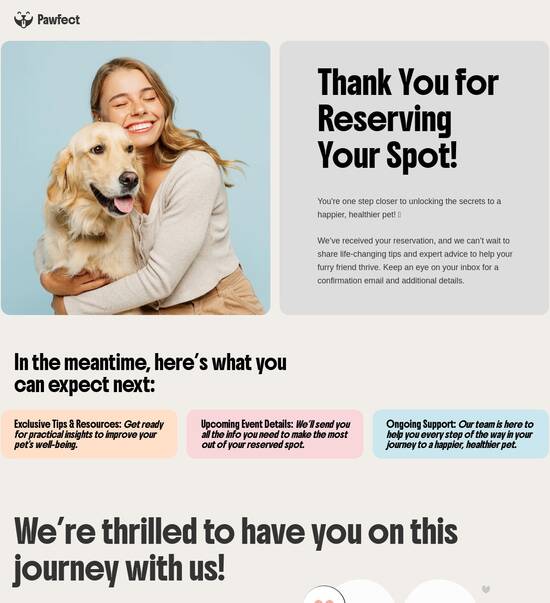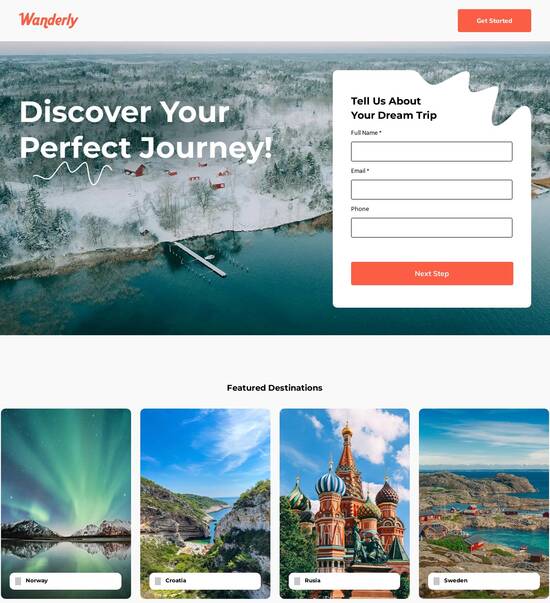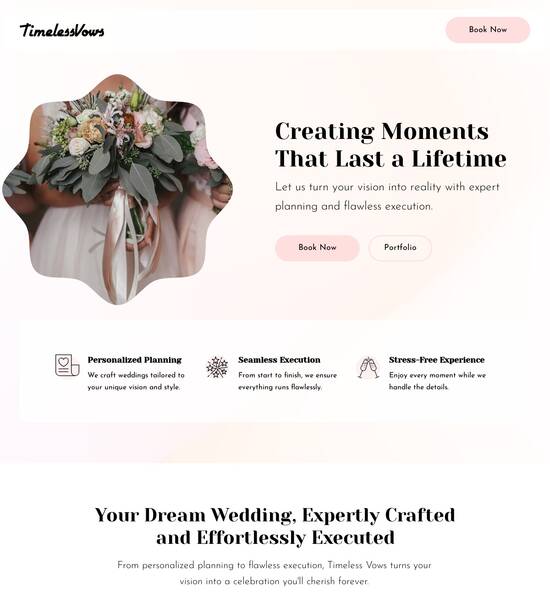
Product page template for UX/UI designers
Explore Similar TemplatesAbout template
Master your online marketing with this builder for product page template for UX/UI designers. Try more tools to create an immaculate landing page.
Recommended templates

Easy to build without coding
With the intuitive drag-and-drop builder, anyone on your team can create high-converting pages without any knowledge of code or design. Make enhancements to your landing page with custom widgets using Javascript, HTML/CSS, or third-party scripts.

Multiple layouts for any industry and goal
Select from 500+ landing page layouts built to boost conversions across industry-specific scenarios. Customize them by adjusting fonts, adding images, and generating on-brand content with the AI assistant. Quickly scale with Instablocks® and Global Blocks that you can save, reuse, and update globally.

Loads fast and looks polished on any device
Every template is responsive, which means they present professionally on any device and load blazingly fast with our Thor Render Engine. You can also power them up with Google AMP technology to deliver an unparalleled mobile experience and drive higher conversions.

Robust analytics & experimentation
Get real-time updates and reporting across all your devices, showing the number of visitors, conversions, cost-per-visitor, and cost-per-lead. Launch AI-powered experiments, run A/B tests, and use heatmaps to analyze user behavior, then optimize your landing page to maximize conversions.







Easy to build without coding
With the intuitive drag-and-drop builder, anyone on your team can create high-converting pages without any knowledge of code or design. Make enhancements to your landing page with custom widgets using Javascript, HTML/CSS, or third-party scripts.
Multiple layouts for any industry and goal
Select from 500+ landing page layouts built to boost conversions across industry-specific scenarios. Customize them by adjusting fonts, adding images, and generating on-brand content with the AI assistant. Quickly scale with Instablocks® and Global Blocks that you can save, reuse, and update globally.
Loads fast and looks polished on any device
Every template is responsive, which means they present professionally on any device and load blazingly fast with our Thor Render Engine.
Robust analytics & experimentation
Get real-time updates and reporting across all your devices, showing the number of visitors, conversions, cost-per-visitor, and cost-per-lead. Launch AI-powered experiments, run A/B tests, and use heatmaps to analyze user behavior, then optimize your landing page to maximize conversions.
All the features you need to build lead-generating landing pages
Explore more featuresLearn how to build top-performing landing pages for any goal
FAQs
Leading the way in building high-performing landing pages





A step-by-step guide to using Instapage for landing page optimization
Marketing teams in the USA often face challenges in converting leads into customers. Instapage is the most powerful landing page and CRO platform designed to empower marketers to accelerate, optimize, and maximize the ROI of their campaigns. This guide will walk you through the essential steps to create effective landing pages using Instapage.
Understanding the fundamentals of Instapage
To effectively use Instapage, it's important to understand its core features. Instapage offers over 100 high-converting templates, intuitive builders, and powerful lead generation elements. These tools allow marketers to launch pages quickly without needing coding skills, making it perfect for any team size or budget.
- High-converting templates: Access a wide selection of templates that are proven to drive conversions.
- Drag-and-drop builder: Easily create and customize landing pages with a user-friendly interface.
- Lead capture elements: Incorporate forms and CTAs that effectively capture leads.
Step 1: Crafting your landing page
Start by selecting a template that aligns with your campaign goals. Adjust colors, images, and text to match your branding while utilizing the drag-and-drop builder.
- Choose a template that resonates with your audience and campaign objectives.
- Edit the content to include compelling headlines and persuasive messaging.
- Integrate visuals that enhance the user experience while supporting the call to action.
Step 2: Optimizing for conversions
Once your landing page is crafted, leverage Instapage's built-in optimization tools to increase conversion rates. Perform A/B testing to compare variations and improve performance.
- Use heatmaps to analyze user behavior and optimize page layout.
- Run A/B tests between different headlines or images to determine which performs better.
- Monitor the analytics dashboard to track page performance and make data-driven adjustments.
Step 3: Personalization and collaboration
Enhance user engagement by personalizing experiences for different audience segments. Instapage allows for dynamic text replacement, aligning ads with specific landing pages.
- Segment your audience to tailor unique experiences for different groups.
- Utilize AdMaps to ensure consistent messaging between ads and landing pages.
- Collaborate with team members in real time, providing feedback and making edits to streamline the production process.
By following these steps, you can maximize the potential of your digital marketing campaigns using Instapage. Each feature is designed to enhance lead generation and improve conversion metrics.
Start creating high-converting landing pages today with Instapage. Take advantage of our powerful tools to boost your marketing efforts and maximize ROI.
People also ask about Product page template for UX/UI designers
Unpacking the essential components of a product page template for ux/ui designers
Understanding the core purpose of product page templates
A product page template serves as a foundational blueprint for presenting products efficiently and effectively. For UX/UI designers, these templates are crucial in creating a seamless shopping experience that meets both user needs and business objectives. With structured templates, designers can focus on creativity and innovation while ensuring that essential elements are included in every product display.
Having a standardized product page template not only saves time but also improves consistency across different product listings. This consistency is vital in reinforcing brand identity and building customer trust. UX/UI designers benefit significantly from structured approaches, allowing them to design with intention while adapting to evolving user expectations.
Aligning product page templates with business goals
Enhanced conversion rates: Well-designed templates help guide users toward making purchases.
Improved customer retention: Familiarity with template layouts can boost repeat visits and purchases.
Increased brand visibility: Consistent templates reinforce brand recognition across various products.
Each of these objectives shapes design decisions, guiding the selection of layout, visuals, and interactivity. By aligning templates with business goals, designers can create compelling product pages that resonate with users and drive desired outcomes.
Features and functionalities of an ideal product page template
An ideal product page template combines critical design elements with user-centric features to enhance the overall user experience. Key sections such as product images, detailed descriptions, specifications, and pricing information must be prioritized. High-quality images and descriptive texts provide clarity, while product specifications help users make informed decisions.
Additionally, functionalities like zoom features on images, quick view options, and easily accessible product reviews contribute significantly to user satisfaction. Such features not only streamline the browsing experience but also engage potential customers, leading to increased time spent on the page and enhanced chances of conversion.
User experience-centric features
Mobile responsiveness: Design templates that adapt effortlessly to different screen sizes.
Fast loading times: Minimize load times to improve user engagement and search engine rankings.
Interactive elements: Incorporate features such as product comparison, social sharing buttons, and user-generated reviews.
These elements cater to user needs and foster a sense of interactivity, driving engagement and trust. UX/UI designers must continuously iterate on these features to ensure that they align with changing user behaviors and preferences.
Versatile template formats
The format of a product page template can significantly influence user experience and engagement. There are various layouts to consider, and each serves a specific purpose depending on the type of product being offered. For instance, grid views are often favored for visual appeal and showcasing many products simultaneously, while list views can provide detailed information on fewer items.
Grid views: Suitable for fashion and lifestyle products where visuals are paramount.
List views: Better for products requiring detailed descriptions, like tech gadgets or software.
Custom layouts: Allow for greater flexibility based on specific sales campaigns or seasonal promotions.
By understanding the characteristics of different target audiences, designers can select the most effective format for their product pages, ensuring that the presentation aligns with user expectations.
In-depth look at the design briefing process
Crafting a comprehensive design brief is pivotal for guiding the creation of product page templates. A well-structured brief should encompass project objectives, specify target audience demographics, and clarify functional requirements. This foundational document serves as a roadmap for designers, enabling them to maintain focus while iterating on their ideas.
Project objectives: Define clear goals such as increasing conversions or improving user engagement.
Target audience specifications: Detail the demographics and preferences of users to inform design decisions.
Functional requirements: Identify necessary features and functionalities that support user experience.
By utilizing a robust design brief in template creation, designers can ensure that their products are well-aligned with both user needs and business goals. Real-world examples show how effective briefs can lead to successful designs that enhance user satisfaction and drive conversions.
Navigating user needs and expectations
Understanding user needs is essential for designing effective product page templates. Researchers can utilize various methods to gather information on user preferences, such as conducting surveys, interviewing customers, or performing user testing. These insights help to shape design decisions, ensuring they align with actual user behavior and expectations.
Surveys: Collect data from users regarding their preferences and pain points.
User testing: Observe users interacting with product pages to identify obstacles and areas for improvement.
Behavioral segmentation: Analyze user behaviors to create distinct audience segments for targeted design strategies.
Merging user needs with business goals also ensures that templates remain relevant and effective. Strategies for balancing these two aspects include prioritizing user-friendly features that support conversion metrics. Case studies demonstrate this synergy, showing how understanding user needs results in successful templates that drive business growth.
Innovative ux/ui design tools for template development
Several design tools can significantly enhance the template creation process for product pages. These tools offer unique features that streamline collaboration and enable rapid iteration based on feedback. Popular tools among UX/UI designers include Figma, Sketch, and Adobe XD, each known for specific strengths in design and prototype development.
Figma: Known for its collaborative features, allowing multiple stakeholders to work in real-time.
Sketch: Offers robust design and prototyping capabilities, particularly favored for its plugins.
Adobe XD: Provides a user-friendly interface for rapid prototyping and offers integration with other Adobe tools.
Incorporating feedback from team members and potential users leads to informed design decisions. Best practices for gathering this feedback include conducting usability testing sessions and encouraging open discussions. Designers who iteratively refine their templates based on feedback are more likely to achieve optimal user experiences.
Best practices for designing effective product page templates
Maintaining consistency and branding throughout product page templates is crucial. Aligning templates with overall branding guidelines helps in achieving a coherent visual identity. To do this, designers should focus on typography, color schemes, and visual hierarchies that reflect the brand's personality and values.
Typography: Use fonts that align with the brand's tone and enhance readability.
Color schemes: Select colors that evoke the desired emotional response and maintain brand recognition.
Visual hierarchy: Prioritize elements to guide user attention effectively.
Optimization strategies are also essential to boost performance. Practical tips include compressing images to improve load speed and implementing responsive design principles. A/B testing can refine template designs based on user interactions, ensuring continuous improvement of conversion rates.
Accessibility considerations in design
Designers must prioritize accessibility to ensure product page templates are usable by a diverse audience. Accessibility involves accounting for various user demographics, including individuals with disabilities. Strategies for achieving inclusivity in design can include using appropriate contrast levels for text, providing alternative text for images, and ensuring compatibility with screen readers.
Contrast ratios: Ensure text is easily readable against background colors.
Alternative text: Provide descriptive text for images to assist visually impaired users.
Keyboard navigation: Ensure that all functionalities are accessible via keyboard.
By incorporating these accessibility features into product page templates, designers contribute to a more inclusive online shopping experience, benefiting both users and businesses.
Realizing the potential of customization and scalability
Customization is vital in making product page templates suitable for various types of products or services. Designers should create adaptable templates that can easily shift to accommodate distinct promotions, seasonal trends, or new product launches. An effective template allows for easy updates, ensuring that the product page remains relevant and appealing.
Adaptable layouts: Design templates that can shift between different layouts or styles with minimal effort.
Flexible elements: Allow for the addition or removal of certain features based on campaign needs.
User-driven customization: Provide options for users to tailor their product views based on preferences.
Scalability is another important consideration. As product catalogs grow, templates must evolve accordingly. This adaptability ensures that designs remain appealing and functional, regardless of the ever-growing range of offerings.
Leveraging analytics for continuous improvement
Tracking success metrics post-launch is essential for measuring the effect of product page templates. Critical metrics include conversion rates, user engagement statistics, and cart abandonment rates. Utilizing tools like Google Analytics and heat maps, designers can gather insights on user behavior and identify areas for improvement.
Conversion rates: Measure the percentage of users who make a purchase.
Engagement statistics: Assess how long users spend on product pages and which features they use.
Cart abandonment rates: Analyze why users leave items in their carts without completing purchases.
Establishing feedback loops is a best practice for ongoing optimization of product page templates. Regularly reviewing user data allows designers to refine templates based on real user interactions, ultimately leading to enhanced user experiences and improved conversion rates over time.
Case studies highlighting successful template implementations
Analyzing successful product page templates from leading brands provides valuable lessons. Brands that have successfully implemented user-centric designs demonstrate the impact of well-crafted templates on conversion rates and customer engagement. Notable examples highlight the importance of strategic layout decisions, imagery use, and information hierarchy.
Brand A: Increased conversion rates by 30% after redesigning their product pages with clearer CTAs and streamlined navigation.
Brand B: Improved customer feedback and engagement through user-generated content and integrated reviews.
Brand C: Successfully utilized dynamic personalization features to tailor product suggestions based on user behavior.
These case studies emphasize the significance of innovative design strategies in creating effective product page templates that meet user expectations and facilitate business goals.
Future trends in product page design
Looking ahead, several trends are expected to influence product page design. As user behaviors and preferences evolve, designers must remain adaptable and open to integrating new technologies. Trends such as utilizing augmented reality (AR) for product visualization and leveraging artificial intelligence (AI) for personalization are expected to reshape user experiences.
Augmented reality: Allow users to visualize products in their environments before purchasing.
Artificial intelligence: Use AI to deliver tailored suggestions based on user interaction patterns.
Interactive elements: Continuous innovation in interactivity will enhance engagement at every touchpoint.
As these emerging technologies redefine user expectations, UX/UI designers must proactively adapt their approach to maintain relevance and appeal in the ever-evolving digital landscape.
Ready to skyrocket conversions?
Supercharge your ad campaigns with high-performing landing pages
Get started














